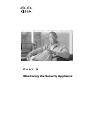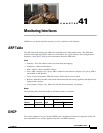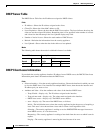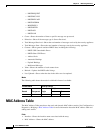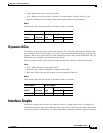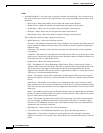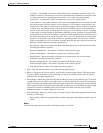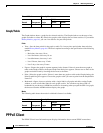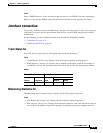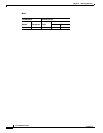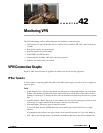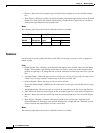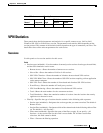
41-6
Cisco ASDM User Guide
OL-16647-01
Chapter 41 Monitoring Interfaces
Interface Graphs
Fields
• Available Graphs for—Lists the types of statistics available for monitoring. You can choose up to
four types of statistics to show in one graph window. You can open multiple graph windows at the
same time.
–
Byte Counts—Shows the number of bytes input and output on the interface.
–
Packet Counts—Shows the number of packets input and output on the interface.
–
Packet Rates—Shows the rate of packets input and output on the interface.
–
Bit Rates—Shows the bit rate for the input and output of the interface.
–
Drop Packet Count—Shows the number of packets dropped on the interface.
These additional statistics display for physical interfaces:
–
Buffer Resources—Shows the following statistics:
Overruns—The number of times that the security appliance was incapable of handing received
data to a hardware buffer because the input rate exceeded the security appliance capability to
handle the data.
Underruns—The number of times that the transmitter ran faster than the security appliance
could handle.
No Buffer—The number of received packets discarded because there was no buffer space in the
main system. Compare this with the ignored count. Broadcast storms on Ethernet networks are
often responsible for no input buffer events.
–
Packet Errors—Shows the following statistics:
CRC—The number of Cyclical Redundancy Check errors. When a station sends a frame, it
appends a CRC to the end of the frame. This CRC is generated from an algorithm based on the
data in the frame. If the frame is altered between the source and destination, the security
appliance notes that the CRC does not match. A high number of CRCs is usually the result of
collisions or a station transmitting bad data.
Frame—The number of frame errors. Bad frames include packets with an incorrect length or
bad frame checksums. This error is usually the result of collisions or a malfunctioning Ethernet
device.
Input Errors—The number of total input errors, including the other types listed here. Other
input-related errors can also cause the input error count to increase, and some datagrams might
have more than one error; therefore, this sum might exceed the number of errors listed for the
other types.
Runts—The number of packets that are discarded because they are smaller than the minimum
packet size, which is 64 bytes. Runts are usually caused by collisions. They might also be caused
by poor wiring and electrical interference.
Giants—The number of packets that are discarded because they exceed the maximum packet
size. For example, any Ethernet packet that is greater than 1518 bytes is considered a giant.
Deferred—For FastEthernet interfaces only. The number of frames that were deferred before
transmission due to activity on the link.
–
Miscellaneous—Shows statistics for received broadcasts.
–
Collision Counts—For FastEthernet interfaces only. Shows the following statistics:
Output Errors—The number of frames not transmitted because the configured maximum
number of collisions was exceeded. This counter should only increment during heavy network
traffic.




